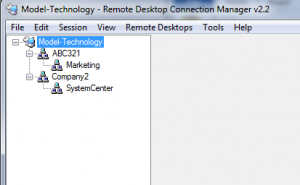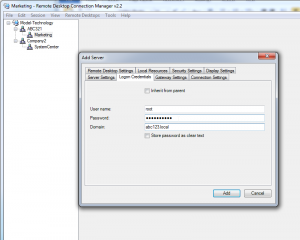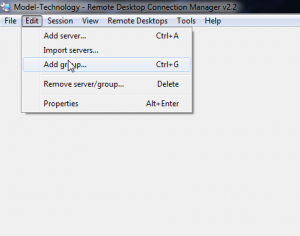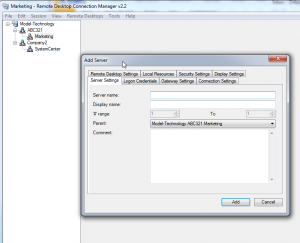This is my first post in a series on The Admins Toolbox.
Remote Desktop Manager (RDC Man) See the list of updates and bug fixes below.
Do you have 10, 20, 30, 1000+ servers that need to be managed ? You should look at Remote Desktop Manager (RDC Man) from Microsoft.
As a consultant I am requested to remember server names user ids and password for more than one client. To help with this I often use RDC Man and a USB drive. Let me show you how.
First download and install Remote Desktop Connection Manager.
It will install into the x86 Program Files folder on a x64 machine:
C:\Program Files (x86)\Microsoft\Remote Desktop Connection Manager
Download from Microsoft using this link: Remote Desktop Connection Manager I keep a copy of the source on the same USB drive with the settings files.
After you have RDCMAN installed, you will need to create a new connection settings file.
From the File menu, click New and select a location to save your new file group. The top-level unit of organization in RDCMan is a remote desktop file group. The RDG files are portable, and you can share them within your organisation. File groups are collections of groups and/or servers that are stored in a single physical file. Servers can’t live outside of a group and groups can’t live outside of a file.
I would create a file group per company and save it to the USB drive.
Add a group.
Now that you have an empty file group, it is time to add your servers and groupings. Groups can be used to organize companies, clients, departments, functions, locations, etc. as well as managing settings (you can specify certain settings that should be inherited from the parent). At this point, you can right click on the node in the tree and Add Server.

Now start adding servers to the groups. If there are only a few add them one at a time, if there are many a text file can be used. The format is one server per line. I have found some PowerShell scripts that will query AD for computer names and output to a text file. All servers are imported into the same group with the same preferences. If a server is imported that has the same name as an existing server, the existing server’s preferences are updated to the new ones.

The connection details:
Server Name (i.e. the address to connect to). This is the DNS name or the IP address for the server
The Logon Credentials property page contains options pertaining to remote login. The user name, password, and domain are set on this page. The domain and user name can be specified together by using the domain\user format. When logging in local rather than a Windows domain, you can specify [server]. This will be substituted with the machine name at logon time. It is useful when you have a group of machines which require logging in as administrator. The Logon Settings entered in the properties pages are used by default for new connections. If you want to temporarily customize these settings for a new connection, connect using the Connect As menu item.
That’s it for now look for more tools over the next few months.
The help file is located in a sub directory called Resources, unsurprisingly this is called help.htm
2.7 Fixes & Features
From the above help file. Please review the help file for details.
New features
- Virtual machine connect-to-console support
- Client size options come from the application config file (RDCMan.exe.config) rather than being hard-coded.
- View.Client size.Custom menu item shows the current size
- View.Client size => From remote desktop size
- Option to hide the main menu until Alt is pressed. Hover over the window title also shows the menu.
- Added Smart groups
- Support for credential encryption with certificates
- Better handling of read-only files
- Added recently used servers virtual group
- New implementation of thumbnail view for more predictable navigation
- Thumbnail view remembers scroll position when changing groups, etc.
- Performance improvements when loading large files
- Allow scale-to-fit for docked servers (Display Settings.Scale docked remote desktop to fit window)
- Allow scale-to-fit for undocked servers (Display Settings.Scale undocked remote desktop to fit window)
- “Source” for inheritance in properties dialog is now a button to open the properties for the source node.
- Focus release pop up => changed to buttons, added minimize option.
- Added command-line “/noconnect” option to disable startup “reconnect servers” dialog
- Session menu items to send keys to the remote session, e.g. Ctrl+Alt+Del
- Session menu items to send actions to the remote session, e.g. display charms
- Domain=”[display]” means use the display name for the domain name.
Bugs fixed
- Application is now DPI aware
- Undocking a server not visible in the client panel resulted in the client not being shown in undocked form.
- Ctrl+S shortcut didn’t work at all. It now works and always saves, even if there are no detected changes to the file.
- Shortcut keys didn’t work when focus was on a thumbnail.
- Add/delete profile in management tab. In same dialog instance, profiles are not updated. Similarly adding a new profile from combo doesn’t update the tab.
- Window title was not updated when selected node is removed and no new node selected (open a file, close the file.)
- Connect via keyboard didn’t always give focus when it should.
- Connected Group would always show itself upon connecting to a machine, regardless of setting.
- Selecting a built-in group then hiding via menu option didn’t work properly.
- Editing server/group properties did not always mark a file as changed.
- Non-changes could result in save prompts at exit. This should no longer happen.
- Activating the context menu via the keyboard button was not always operating on the correct node.
- Changing a server/group name doesn’t change window title if the server/group is currently selected.
- ALT+PAGEUP and ALT+PAGEDOWN hotkeys were switched. This is fixed for new installs—for existing files you’ll want to change on the [Tools.Options.Hot Keys] tab.
- /reset command line option wasn’t resetting all preferences
- “Server Tree” option from “Select server” focus release dialog didn’t show the server tree if it was hidden.
- New file directory now defaults to “Documents”.
- ListSessions dialog sometimes popped up in a weird location. Now placed within the main window

